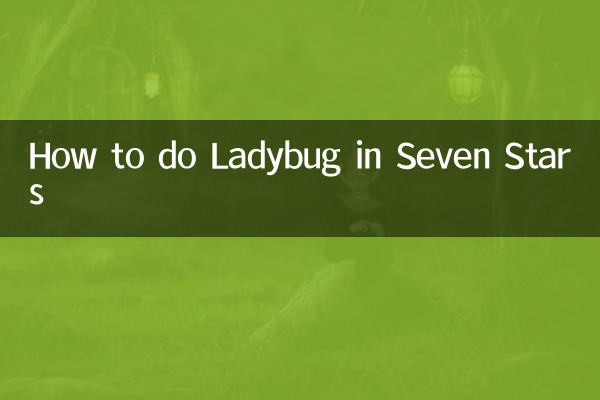How to do Ladybug in Seven Stars
The Seven Star Ladybug is a common beneficial insect, named after its seven black spots on its back. They feed on pests such as aphids and mites, and are important natural enemies in agriculture and horticulture. This article will introduce in detail the breeding methods, living habits of ladybugs, and how to use them for biological control.
1. The life habits of the seven-star ladybug

The Seven Star Ladybug belongs to the Ladybug family of Coleoptera. The adult body is 5-8 mm long, with red or orange-red back, and has seven obvious black spots. They prefer warm and humid environments and are often active in spring and summer. Both the larvae and adults of the Seven Star Ladybug feed on aphids, and an adult can eat dozens of aphids every day.
| Life cycle phase | Duration | Main Activities |
|---|---|---|
| egg | 3-5 days | Female lays eggs on aphid-intensive plants |
| larva | 10-15 days | Prey on aphids in large quantities and molt 3 times |
| pupa | 5-7 days | Attach to plants and do not eat |
| Adult | 2-3 months | Continue to prey on aphids and reproduce offspring |
2. Breeding methods for the seven-star ladybug
Raising a seven-star ladybug requires providing a suitable environment and sufficient food source. The following are the specific breeding steps:
1.Prepare a breeding container: Choose a well-ventilated transparent container, such as a plastic box or glass tank, with moist paper towels or cotton at the bottom.
2.Provide food: The main food of ladybugs is aphids, and plants with aphids can be placed in containers. Artificial feeds such as honey water or yeast powder can also be used.
3.Control environmental conditions: Keep the temperature at 20-25℃ and the humidity at 60-70%. Avoid direct sunlight and provide proper light.
4.Reproductive management: Female insects lay eggs on plants densely packed with aphids, and hatched larvae need to provide timely food.
| Breeding points | Specific requirements |
|---|---|
| Container size | At least 10 liters of space is required for every 100 ladybugs |
| Food supply | 10-20 aphids are needed per ladybug every day |
| Cleaning management | Clean the container 1-2 times a week to avoid mold growth |
3. Use the Seven Star Ladybug for biological control
The Seven-Star Ladybug is the natural enemy of aphids, which can effectively control the number of aphids and reduce the use of pesticides. The following are methods for biological control using ladybugs:
1.Time to release: Releases the ladybugs when the aphid population begins to rise, usually in spring and early summer.
2.Number of releases: Release 100-200 adults, or 500-1,000 larvae per mu.
3.Release method: Distribute ladybugs evenly on the victim plants to avoid release during rainy days or high temperatures.
4.Follow-up management: Reduce the use of pesticides and protect the living environment of ladybugs.
| Crop Type | Recommended release quantity (per acre) |
|---|---|
| vegetable | 150-200 adults |
| Fruit Tree | 200-300 adults |
| flowers | 100-150 adults |
4. Things to note
1. Ladybugs are sensitive to pesticides and should avoid spraying pesticides when using them.
2. Pay attention to maintaining humidity during breeding to avoid the container being too dry.
3. Adult ladybugs are phototaxis, and direct light should be avoided in breeding containers.
4. After releasing the ladybug, the prevention and control effect should be checked regularly and the release should be supplemented if necessary.
Through scientific breeding and release methods, Ladybugs of Seven Stars can become a good assistant in agricultural production, helping to reduce the use of chemical pesticides and protect the ecological environment.

check the details

check the details